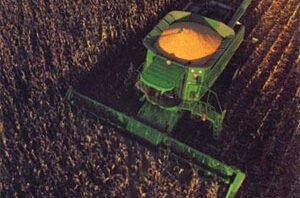Criticisms of genetically engineered (GE) food have gone mainstream lately — from Chipotle going GMO free to GE labeling bills moving forward in states across the country. But very little public attention has been given to the important crossroads we are facing right now around how GE crops get onto the market to begin with.
After the controversial approval of Dow Chemical’s latest GE corn and soybeans, Enlist Duo, USDA announced it will finally be revising the agency’s outdated, ineffective, hands-off approach to regulating GE crops. We have until June 22nd to weigh in on how GE products should be evaluated before they enter our fields, and how the USDA should regulate them once they are planted. So what needs to change?
Strong GE regulation is needed
Urge USDA to strengthen GE oversight, today! 
Regulations for GE products haven’t been rewritten since the 1990s, when RoundUp Ready crops were first coming onto the market. With three agencies (EPA, FDA, and USDA) involved in small pieces of the GE approval process, there are huge loopholes and outdated practices that don’t take into consideration today’s agricultural challenges.
USDA announced in March that it will not only revise its current system for GE oversight, but will in fact scrap the current system entirely and create new oversight guidelines from scratch. While it’s hard to suspend my skepticism that the USDA will suddenly change course and get tough on the Big 6, I will say that the prospect of a regulatory overhaul is pretty exciting.
Broaden the scope
First and foremost, we need to redefine the scope of USDA’s regulatory mandate around GE. Currently, the agency is wearing self-imposed blinders that block out the most critical threats posed by GE products — namely, the health, environmental, and livelihood impacts of the pesticides with which the crops are designed to be used.
For a case in point, see USDA’s decision on 2,4-D resistent corn and soybeans. The agency refused to consider the harms to surrounding farms and families that would be caused by the drastic increased use of the toxic herbicide 2,4-D that Dow Chemical’s new product is projected to cause. Instead, USDA focused only on the harms cause by drift of genetic material into neighboring fields, known as GMO contamination. While this is without a doubt an important factor to consider, it is by no means the central one.
USDA is scrapping the current system of GE oversight, and creating new guidelines from scratch.
When weighing approval for new GE crop systems, USDA must consider the accompanying impacts that both the GMOs and their accompanying pesticides will have, including: crop damage and health consequences from drift, rapid evolution of herbicide-resistant weeds, and transgenic contamination. Furthermore, evaluation of these factors should be based on field studies designed and conducted by independent scientists, NOT industry controlled experiments.
In case of emergency, move quickly!
Another high-level concern which is relevant to most of our regulatory agencies and certainly to USDA, is the need for ongoing regulation and responsive action after the initial approval process. As things stand, once GE crops make it over the very low approval bar set by USDA, they are then ignored for a decade or more. In the past 20 years, RoundUp Ready has changed agriculture as we know it, and given birth to a whole series of new problems for farmers and rural communities to deal with — while USDA sits on the sidelines.
New conditions should trigger new regulation. When we discover new cancer risks (for example, the IARC’s recent classification of glyphosate as a probable carcinogen) or new superweeds, our agencies need to weigh in immediately instead of waiting years for a scheduled review process.
The comment period is open until June 22nd. Please sign our petition or send USDA your thoughts today!








